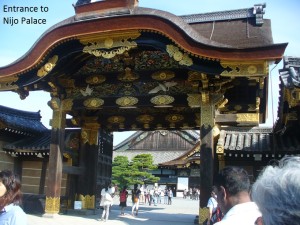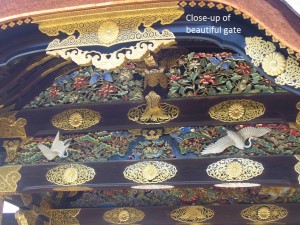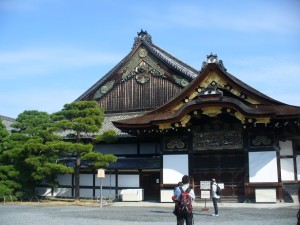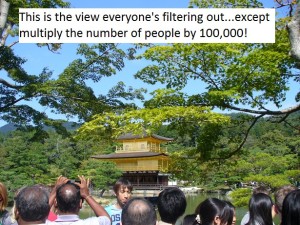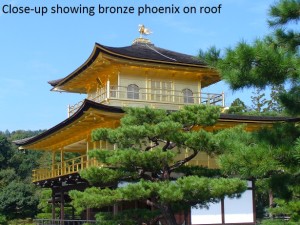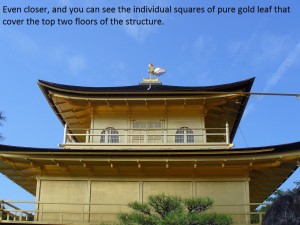
Day 5
Today we went to see Nijo Palace, Kinkaku-ji Temple, and the Kyoto Imperial Palace. This was a much bigger tour, with a whole bus-load of other people who were going on to do Nara in the afternoon or more of Kyoto. We weren’t familiar with the guide since we joined them mid-tour, but she wasn’t as cheery as Yumi, our guide from yesterday (probably because she had to stress over so many people!).
The building of Nijo Castle began in 1601, when Tokugawa Ieyasu, founder of the Tokugawa Shogunate, ordered all feudal lords in Western Japan to contribute to its construction. It was built as the Kyoto residence of the Tokugawa Shoguns. The Tokugawa Shogunate used Edo as the capital city, but Kyoto continued to be the home of the Imperial Court. Kyoto Imperial Palace is located north-east of Nijo Castle.
In 1867, the Tokugawa shogunate returned the authority to the Imperial Court and the Imperial Cabinet was installed in the castle. The palace became imperial property and was declared a detached palace. During this time, the Tokugawa hollyhock crest was removed wherever possible and replaced with the imperial chrysanthemum. In 1939, the palace was donated to the city of Kyoto and opened to the public the following year.
The guide pointed out the great rooms of tatami mats, devoid of furniture, with shoji doors which could be rearranged at any time to change the size and placement of rooms. There were mannequins set up so we could see how social control was maintained through the architecture – the powerful shogun at the far end on a raised dais, the samurai lined up in rows before him according to rank. Bodyguards had special alcoves where they were displayed (or sometimes hidden) as they protected their leader. We also got to see the living quarters of the shogun, where only female attendants were allowed. It was pretty impressive.
One of the most striking features of the Ninomaru Palace are the “nightingale floors” in the corridors. To protect the occupants from sneak attacks and assassins, the builders constructed the floors of the corridors in such a way as to squeak like birds when anyone walks on them. And this is where I learned that the creaking floors I experienced in Daitoku-ji were indeed created on purpose, and I got to see the special nails and hooks attached to the floorboards which were behind the sounds. According to the guide, the boards creaked more the slower you walked on them….ingenious!
The Kinkaku-ji (Temple of the Golden Pavilion) was simply stunning. It was originally a villa of a powerful statesman, then bought by a shogun to use has his retirement home. After the shogun died his son converted it into a Zen temple, according to his wishes. In 1950, the temple was burned down by a novice monk, who then tried to commit suicide (he was unsuccessful and taken into custody, where he remained for 7 years before being released due to mental illness).
The temple was rebuilt in 1955 and is said to be a close copy of the original, although some believe the amount of gold was increased. For sure it is nearly gaudy in color. (Mil said, “I don’t think I understood it would be quite so gold.” *LOL* It’s a bright, light yellow….I myself thought it would be a deeper “golden” color!) It’s a 3-story building and the top 2 stories are covered in thick gold leaf – you can actually see the individual squares if you look closely.
It was an amazing sight, and the garden and ponds were beautiful too. But I wish I had gotten a photo of the number of people who were there! The crowds of tourists were incredible, milling about in swarms trying to take pictures, and every once in awhile a guard with gloves and a whistle would blow and motion them to move on. It was a madhouse, and we were desperately trying not to lose sight of the guide, because she’d mentioned the bus would be leaving without us if we were late.
After that the Imperial Palace was almost anti-climactic. It is the former ruling palace of the Emperor of Japan (who has resided at the Tokyo Imperial Palace since the Meiji Restoration [1869]….in fact my Tokyo guide told me that “Tokyo” means “east Kyoto” *g*) , but even though no one lives there anymore the security is very strict. We had to list ourselves prior to signing up for the tour, and then once again that day before entering the compound. Once there we had to line up in rows of four and be counted going in and going out.
I’ll include some pictures of the grounds (very Zen – large areas of white gravel and very few trees) and gates (wonderful carvings), but don’t really have much to say about the buildings themselves, because I missed a lot of it. The group was so large, there were many groups and guides speaking loudly, and it was so hot I was just sort of looking for shade and snapping pictures. If I had it all over to do again, I’m not sure I would’ve visited this place. I think I’d opt for more countryside, or gardens, or one of the many islands/villages on the coast. But maybe that’s just me.
Witten by Suzette Tom
